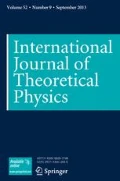Abstract
In this paper, we present the annihilation and creation operators for a moving scalar massive particle on 1 + 1-de Sitter space. This presentation is based on coherent states method and Hall-Mitchell approach about annihilation operator for a system which its phase space is \( S_{\mathcal {C}}^{n} \). We show that these operators coincide with the Ladder operators for a quantum particle on circle which was presented by Kowalski-Rembielinski-Papaloucas (both cases have the same phase spaces).
Similar content being viewed by others
Notes
For simple and semi-simple groups, the adjoint orbit is equivalent to phase space.
References
Hall, B., Mitchell, J.J.: Coherent states on spheres. J. Math. Phys. 43(3), 1211–1236 (2002)
Thiemann, T.: Reality conditions inducing transforms for quantum gauge field theory and quantum gravity. Class Quantum Grav. 13, 1383–1403 (1996)
Thiemann, T.: Gauge field theory coherent states (GCS): I. General properties. Class Quantum Grav. 18, 2025–2064 (2001)
Berezin, F.A.: Quantization. Math.USSR Izvestija 8, 1109–1165 (1974)
Kowalski, K., Rembielinski, J., Papaloucas, L. C.: Coherent states for a quantum particle on a circle. J. Phys. A: Math. Gen. 29, 4149 (1996)
Rabeie, A.: These de doctorat de l’universite de MARNE-LA-VALLEE Physique quantique des systeme elementaires dans de Sitter (2005)
Kirillov, A.A.: Unitary representations of nilpotent lie groups. RUSS MATH SURV 17, 53–104 (1962)
Kirillov, A. A.: Merits and demerits of the orbit method. Bull. Amer. Math. Soc. 36, 433–488 (1999)
Kirillov, A.A.: Elements of the Theory of Representations. Springer, Berlin Heidelberg New York (1976)
Kirillov, A.A.: Lectures on the Orbit Method. American Mathematical Society (2004)
Gazeau, J. P., Lachieze-Rey, M., Piechocki, W.: On three quantization methods for particle on hyperboloid. arXiv:gr-qc/0503060 (2005)
Perelomov, A. M.: Generalized Coherent States and their Applications. Springer, Berlin (1986)
Sugiura, M.: Unitary Representations and Harmonic Analysis. Kodansha Scientific Books (1990)
Vilenkin, N.J.: Special functions and the theory of group representations. American Mathematical Society Providence (1968)
Rabeie, A.: Quantum physics of an elementary system in de Sitter space. Eur. Phys.J.C 72, 2135 (2012)
Author information
Authors and Affiliations
Corresponding author
Additional information
Publisher’s Note
Springer Nature remains neutral with regard to jurisdictional claims in published maps and institutional affiliations.
Appendix A
Appendix A
1.1 A.1 A Brief About the Group and Algebra of 1 + 1-de Sitter
1 + 1-de Sitter space is a hyperboloid “MH” embedded in a three-dimensional Minkowski space:
where H is the Hubble constant. The associated symmetric group is SO(1, 2) but we use its covering group i.e. unitary group SU(1, 1) that is represented by [14]:
This group act on matrix \(\mathcal {X}\) as follows:
where
The factorization of group SU(1, 1) is represented by [6] :
Also, three-parameter group SU(1, 1) induce the following vectors in associated Lie algebra “su(1,1)”:
Namely, an element of su(1,1) is expressed by:
where \(y \in \mathcal {R}\) and \(z \in \mathcal {C}\).
1.2 A.2 Construction of Phase Space by the Orbit Method
In the paper [15], by using the Kirillov orbit method [7,8,9,10], we have shown that the phase spaceFootnote 1 of a scalar massive particle on 1 + 3-de Sitter space is cotangent bundle T∗(S3) which is isomorphic with the complex sphere “\(S_{\mathcal {C}}^{3}\) ”. It is not very difficult to show that the phase space of a scalar massive particle on 1 + 1-de Sitter space is isomorphic with the complex sphere “\(S_{\mathcal {C}}^{1}\) ”. For this propose, we choose the point \(X_{0}=\left (\begin {array}{cc} 0&1\\ 1&0 \end {array}\right )\) of Lie algebra “su(1,1)” (the case y = 0 and z = 0 of equation (60)). This point is invariant under adjoint action of “time” translation matrix i.e.
Therefore, a point of our adjoint orbit is obtained by:
Equations (61) and (62) show that the X0 is invariant under adjoint action of group SO(1, 1) and therefore the adjoint orbit is identified by:
This action (orbit) is transitive and construct a homogeneous space. On the other hand, we know that the homogeneous space for a scalar massive particle on 1 + 1-de Sitter space (on the basis of irreducible representation of group SU(1, 1)) is given by equation (63). Therefore, equation (62) expresses a point of the adjoint orbit for a scalar massive particle on 1 + 1-de Sitter space that corresponds to a point of phase space. By choosing \(``~p=m ~\sinh \varphi \cos \limits \theta ~"\), \(``~p_{0}=m~\sqrt {\sinh ^{2}\varphi ~\cos \limits ^{2}\theta +1}~"\) and \(``~\beta =\frac {1}{2}\arctan \Big (\frac {2 ~\tan \theta ~\cosh \varphi }{\cosh ^{2}\varphi -\tan ^{2}\theta }\Big )~"\) we parameterize (62) as follows:
where \(p_{0}=\pm \sqrt {m^{2}+p^{2}}\). The quantities β and p play the role position and momentum. This expresses that the adjoint orbit (or phase space) of a scalar massive particle on 1 + 1-de Sitter space is identified with cotangent space T∗(S1) that the (β,p) play the role of pair varieties of T∗(S1):
On the other hand, from Thiemann complexification method’s (see [1] for \(m=r=\hbar =1\)) we know that this cotangent space is isomorphic with the complex circle “\(S_{\mathcal {C}}^{1}\) ” i.e.
where \(p^{2}={p_{1}^{2}}+{p_{2}^{2}} \).
1.3 A.3 Calculation of Component of the Annihilation Operators
Just as is mentioned in Section 3, the operator \(\hat {A}_{1}\) is given by:
Now we obtain all of commutation relations in the above equation:
By using equations (68)-(70) in (67), we find that
Rights and permissions
About this article
Cite this article
Rabeie, A., Rezaei, S. The Ladder Operators on 1 + 1-de Sitter Space. Int J Theor Phys 60, 3850–3860 (2021). https://doi.org/10.1007/s10773-021-04929-3
Received:
Accepted:
Published:
Issue Date:
DOI: https://doi.org/10.1007/s10773-021-04929-3


